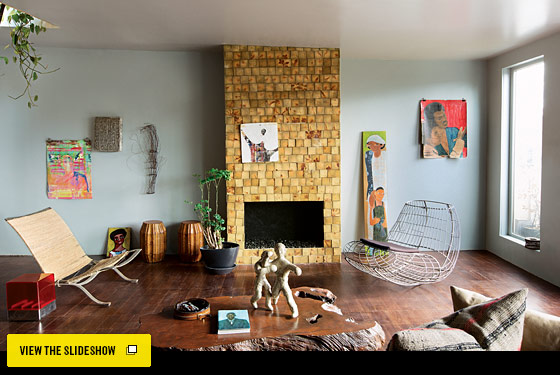
Hank Mitchell’s first big break came when he was still a student at F.I.T., working for the architect Jack Travis. One week, to make some extra cash, he agreed to fill in for a friend answering phones at Esquire. Roger Black, the art director at the time, liked Mitchell’s style and, when he found out he was a designer, asked him to draw up a proposal for his apartment. Mitchell will never forget Black’s response. “Roger said one thing was wrong,” he recalls. “He said, ‘Everything is great but the price. You should charge three times the price.’ ” Since starting his own business in 1995, Mitchell has been busy renovating brownstones, mainly in Brooklyn, where he recently finished his own home in Bed-Stuy. But if Black was his mentor-client, Mitchell’s mother was his inspiration. Growing up in Oakland, California, with seven brothers and sisters, Mitchell was impressed (if often dismayed) by her spontaneous decorating. “You would come home from school, and everything would be rearranged. [My mother] did this constantly.” He liked the adventure of that. What he didn’t like was the pervasive mid-century-modern furniture, not to mention the “fake traditional” that replaced it. And then there was the color scheme: Mrs. Mitchell’s rules were that the living room was always white—the bedrooms got color.
The 1880s frame house that grabbed Mitchell’s heart was an out-and-out disaster—or total adventure—and he knew even before climbing the staircase that he had found the one: “There was light coming in the window at the back, and the garden was overgrown … ” He now luxuriates in what he calls an “inverted floor plan,” with the private spaces downstairs and the kitchen and living room (not painted white) on the top floor. Mrs. Mitchell will be visiting this summer, “but she has heard all about it from my nephews,” says Mitchell. As for moving a bunch of furniture around, he laughs when he thinks of the pieces he has stashed away in storage. “My mother has a garage filled with things she will never have a use for, and that is me. I am my mother’s child.”

The Fireplace
Using four-by-fours left over from a renovation, Mitchell end-cut them for the pattern created by the grain. “My place is a lab, and I want to create ceramic versions of these.”
The Artwork
“My older sister did the drawing by the window when she was a teenager and I was 5 or 6.
It inspired me to have a life in the arts. It hung in my grandmother’s house, and when she passed I asked if I could have it.” The long panel painting beside it is by Aisha Cousins.
The Chairs
The metal Socabot lounger is a prototype by Tony Whitfield for Red Wing & Chambers.
Mitchell re-covered the Arne Norell lounge chair in twine.
Photo: Thomas Loof

The Kitchen
The range is made by Fisher & Paykel. The sink top is Ikea; it rests on chrome legs from a desk purchased at Williams-Sonoma Home. The Coca-Cola sign dates from the fifties.
Photo: Thomas Loof

The Sleeping Nook
Mitchell loves to place his bed in an alcove: “It is a very, very restful sleep.”
Photo: Thomas Loof

The Sink Vanity
Both the vanity and the shelving are custom-designed from salvaged oak beams.
The Showerheads
Mitchell splurged on his bathroom with four recessed shower and body jets from Kohler WaterTiles.
Photo: Thomas Loof

